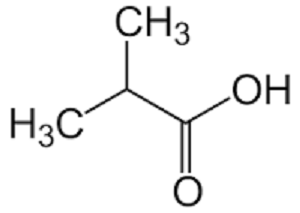Isobutyric Acid

Product Description
Isobutyric Acid, also known as 2-methylpropanoic acid, is a carboxylic acid with various industrial applications.
Product:
Isobutyric Acid
CAS:
79-31-2
Synonym:
2-Methylpropionic acid; 2-methylpropanoic acid; Isobutanoic acid
Structure:

Typical Characteristics
Appearance
Colorless liquid
Boiling point
153-154 °C
Density
0.95 g/cm3
Flash Point
56 °C
Melting point
−47 °C
Molecular Weight
88.11
Odor
Pungent odor
Purity
99%
Refractive index
1.393
Uses, Applications & Markets
Key applications
get a quote
We Offer Isobutyric Acid
in various grades
A few of the grades available are listed below:



Isobutyric Acid used in many
industry applications
Isobutyric Acid, also known as 2-methylpropanoic acid, is a carboxylic acid with various industrial applications. Here's a list of some of its industrial uses:
- Flavoring Agent: Isobutyric Acid is used as a flavoring agent in the food industry, imparting a cheesy or rancid butter flavor to certain foods and beverages. It is commonly found in cheese, butter, and other dairy products, as well as in flavor blends for savory snacks and seasonings.
- Pharmaceuticals: It serves as a precursor or intermediate in the synthesis of pharmaceutical compounds, including esters, amides, and other organic derivatives. Isobutyric Acid is utilized in the production of active pharmaceutical ingredients (APIs) and drug formulations for various therapeutic applications.
- Chemical Synthesis: Isobutyric Acid is employed as a building block or starting material in organic synthesis reactions, particularly in the manufacture of specialty chemicals, fine chemicals, and agrochemicals. It can undergo various chemical transformations, such as esterification, oxidation, and halogenation, to yield a wide range of products.
- Perfumery: It is used as a fragrance ingredient in perfumes, colognes, and other personal care products due to its characteristic odor profile. Isobutyric Acid contributes to the overall scent profile and olfactory characteristics of fragrances, providing fruity, sour, or animalic notes depending on its concentration and formulation.
- Animal Feed Additive: Isobutyric Acid may be included as a feed additive or flavor enhancer in animal feeds and pet foods to improve palatability and stimulate appetite in livestock, poultry, and companion animals. It can help mask undesirable flavors and odors in feed formulations, promoting higher feed intake and better animal performance.
- Organic Solvent: In some industrial processes, Isobutyric Acid is utilized as a solvent or extraction medium for the purification of organic compounds, separation of mixtures, and recovery of valuable chemicals. It exhibits moderate solubility in organic solvents such as ethanol, acetone, and ethyl acetate.
- Flotation Reagent: Isobutyric Acid is sometimes employed as a flotation reagent or frother in mineral processing and ore beneficiation operations to enhance the flotation of valuable minerals from ores. It helps create stable foam layers on mineral surfaces, facilitating the selective separation of minerals based on their hydrophobicity.
- Chemical Intermediates: It is used as an intermediate in the synthesis of various organic compounds, including plasticizers, lubricants, surfactants, and corrosion inhibitors. Isobutyric Acid can undergo esterification, amidation, and other chemical reactions to yield derivatives with diverse industrial applications.
- Microbial Metabolite: Isobutyric Acid is produced as a metabolic byproduct during the fermentation of carbohydrates by certain microorganisms, including bacteria and yeast. It is found naturally in fermented foods such as cheese, yogurt, sauerkraut, and alcoholic beverages, contributing to their flavor and aroma profiles.
- Chemical Research: Isobutyric Acid is utilized as a reference standard or analytical reagent in chemical research laboratories for the qualitative and quantitative analysis of organic compounds. It can be employed in chromatography, spectroscopy, and other analytical techniques for compound identification and characterization.